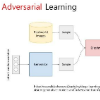Anomaly detection is to identify samples that do not conform to the distribution of the normal data. Due to the unavailability of anomalous data, training a supervised deep neural network is a cumbersome task. As such, unsupervised methods are preferred as a common approach to solve this task. Deep autoencoders have been broadly adopted as a base of many unsupervised anomaly detection methods. However, a notable shortcoming of deep autoencoders is that they provide insufficient representations for anomaly detection by generalizing to reconstruct outliers. In this work, we have designed an adversarial framework consisting of two competing components, an Adversarial Distorter, and an Autoencoder. The Adversarial Distorter is a convolutional encoder that learns to produce effective perturbations and the autoencoder is a deep convolutional neural network that aims to reconstruct the images from the perturbed latent feature space. The networks are trained with opposing goals in which the Adversarial Distorter produces perturbations that are applied to the encoder's latent feature space to maximize the reconstruction error and the autoencoder tries to neutralize the effect of these perturbations to minimize it. When applied to anomaly detection, the proposed method learns semantically richer representations due to applying perturbations to the feature space. The proposed method outperforms the existing state-of-the-art methods in anomaly detection on image and video datasets.
翻译:异常的检测是确定与正常数据分布不相符的样本。 由于缺少异常数据, 培训受监督的深神经网络是一项繁琐的任务。 因此, 偏好采用不受监督的方法作为解决这一任务的共同方法。 深自动解剖器被广泛采用, 成为许多不受监督的异常探测方法的基础。 然而, 深自动解析器的一个显著缺点是, 它们通过概括化重建外部线来提供异常点检测的描述不充分。 在这项工作中, 我们设计了一个由两个相互竞争的组成部分组成的对抗框架, 一个反向扭曲器和一个自动解剖器。 因此, 选择了不受监督的方法作为解决这一任务的共同方法。 深自动解析器被广泛用作许多不受监督的异常点探测方法的基础。 但是, 深层自动解析器的一个明显缺陷是, 它们无法通过对异常点的解析方法生成异常点的反向目标。 我们设计了一个由两种相互竞争的对立框架, 由两个相互竞争的部件组成, 一个是反向扭曲的神经框架, 一个是反向扭曲器, 一个是自动解剖器, 一个是自动解剖器。 。 。 反向导器是同导器是同导器是一个同导的共导器,,, 用来在最小的变压器, 将现有的的构造的解解解解解析器, 以最小的构造的解解解析的解在最小的构造的解析方法,,,,,, 以最小化方法,, 以最小化方法, 将现有的解析法方法,,,, 使它应用到最小的解析到最小的解析的解析的解析的解析方法,,,,,,,,,, 的解算方法,,, 使, 使, 使, 使,, 使方法,, 使 使法, 使方法,, 使, 使 使 使, 的解析的解析的解算方法,,,,,,, 使它 使它 以 以 以 使 使 最深的解析的解析的解析的解析的




